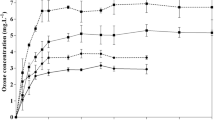Abstract
The purpose of this study was to determine the effects which dihydroquercetin (DHQ) has on the natural healing process of suberization and wound periderm initiation in cut seed potatoes. Dihydroquercetin is a phenolic compound extracted from the bark of Douglas Fir,Pseudotsuga menziesii (Mirb.) Franco.
Anatomical studies of treated seed potato tissue showed that treatment with bark-383, the cork-rich fraction of the whole bark containing approximately 2% pure DHQ, increases the thickness of the suberized layer formed below the cut surface. Treatment with 4% bark fraction I, which is blended to that concentration with the inert carrier dust Pyrax and contains approximately the same amount of DHQ as does the bark-383, also promoted the formation of a thicker layer of suberized cells.
The thickness of the wound periderm did not significantly vary as a result of the use of any treatments containing DHQ. The use of Captan (Orthocide 50W) as a cut seed treatment in these studies was found to inhibit the formation of a suberized layer and subsequently the initiation of a wound periderm. The combination of bark-383 and Orthocide 50W in a treatment mixture reversed the inhibitory affect of the Orthocide 50W alone and therefore allowed for the formation of a well suberized layer and a wound periderm.
It was found that wound healing on the cut surface of seed potatoes is largely dependent on the type of tissue present at any given point on that cut surface. Therefore, the response to treatment of the stolon end, center, and blossom end tissues was related to the type of tissue which was present in each of those tuber regions.
The fungal mold growth on treated seed pieces incubated in a controlled environment was adequately retarded when Orthocide 50W was combined with bark-383 in a mixture ratio of 1:9 respectively. The longer the treatment material was allowed to remain on the seed piece, the greater was the protection against mold growth afforded by the mixture.
Similar content being viewed by others
Literature Cited
Artschwager, Ernst. 1927. Wound periderm formation in the potato as affected by temperature and humidity. J. Agr. Res. 35: 995–1000.
Bloch, R. 1941. Wound healing in higher plants. Bot. Rev. 7: 110–146.
Esau, K. 1967. Plant anatomy. John Wiley and Sons, New York. 767 p.
Hughes, J. C. and T. Swain. 1960. Scopolin production in potato tubers infected withPhytophthora infestons. Phytopathology. 50: 398–400.
Johansen, D. A. 1940. Plant microtechnique. McGraw-Hill Book Company, New York. 523 p.
Johnson, G. 1964. Healing of wounds in plant products. U. S. Pat. 3,124,448.
Johnson, G. and L. A. Schaal. 1952. Relation of chlorogenic acid to scab resistance in potatoes. Science. 115: 627–629.
Johnson, G. and L. A. Schaal. 1957. Accumulation of phenolic substances and ascorbic acid in potato tuber tissue upon injury and their possible role in disease resistance. Amer. Potato J. 34: 200–209.
Johnson, G. and L. A. Schaal. 1957. Chlorogenic acid and other orthodihydricphenols in scab-resistant Russet Burbank and scab-susceptible Triumph potato tubers of different maturities. Phytopathology. 47: 253–255.
Livingston, C. H. 1962. The effects of various treatments on the cut surface of seed potatoes. Amer. Potato J. 30: 2711–281.
Politis, J. 1948. The role of chlorogenic acid in the formation of suberized membranes. Rev. Cytol. Cytophysiol. Vegetable. 10: 232–233.
Priestley, J. G. and L. M. Woffenden. 1923. The healing of wounds in potato tubers and their propagation by cut sets. Ann. Appl. Biol. 10: 96–115.
Sanford, G. B. 1951. Effects of various chemicals on the natural healing of freshly cut potato sets. Phytopathology 41: 1077–1082.
Sass, H. E. 1958. Botanical microtechnique. Iowa State Univ. Press, Ames. 228 p.
Schaal, L. A. and G. Johnson. 1955. The inhibitory effect of phenolic compounds on the growth ofStreptomyces scabies as related to the mechanism of scab resistance. Phytopathology. 45: 626–628.
Shapavalov, M. and H. A. Edson. 1919. Wound-cork formation in the potato in relation to seed-piece decay. Phytopathology. 9: 438–496.
Simonds, A. O., G. Johnson and L. A. Schaal. 1953. Comparative effects of catechol, some related compounds, and other chemicals on suberization of cut potato tubers. Botanical Gazette. 115: 190–195.
Snedecor, G. W. and W. G. Cochran. 1967. Statistical methods. Iowa State Univ. Press, Ames. 593 p.
Tomiyama, K., R. Sakai, T. Sakuma and N. Ishizaka. 1967. The role of polyphenols in the defense reaction in plants induced by infection. p. 165–182.In C. J. Mirocha and I. Uritanif [ed.] The dynamic role of molecular constituents in plant-parasite interactions. Bruce. St. Paul.
Author information
Authors and Affiliations
Additional information
Published with the approval of the Director, Colorado Agricultural Experiment Station as Scientific Journal Series No. 1908
Rights and permissions
About this article
Cite this article
Mizicko, J., Livingston, C.H. & Johnson, G. The effects of dihydroquercetin on the cut surface of seed potatoes. American Potato Journal 51, 216–222 (1974). https://doi.org/10.1007/BF02851415
Received:
Issue Date:
DOI: https://doi.org/10.1007/BF02851415




